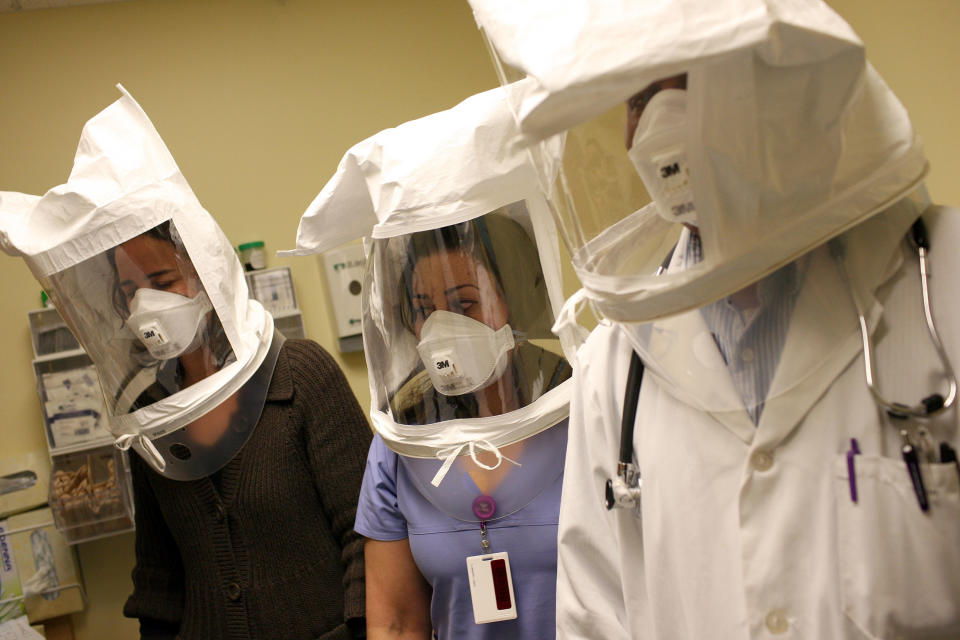New coronavirus revelations emerge as death toll continues to rise
New revelations have surfaced about how the coronavirus can be transmitted as global cases of the deadly disease continue to escalate.
While the 2019-nCoV virus is commonly known to be passed on via the respiratory tract, medical experts are now warning there are other possible transmission routes.
Just days after complaining of having abnormal redness in his eyes, Guangfa Wang, a member of the national expert panel on pneumonia, reported his own contraction of novel coronavirus.
He had been wearing a N95 face mask while working in the Wuhan Fever Clinic, but wore no protection on his eyes and on January 22 reported he was infected.

His case, detailed in peer-reviewed medical journal The Lancet, has led medical experts to warn others of the potential risk of not covering their eyes when in the vicinity of infected people.
“The fact that exposed mucous membranes and unprotected eyes increased the risk of SARS-CoV transmission suggests that exposure of unprotected eyes to 2019-nCoV could cause acute respiratory infection,” the report says.
Authors of the report concluded doctors working with patients confirmed or suspected of having the coronavirus should have analysed conjunctival scrapings during the onset of symptoms.
'A floating prison': How man's luxury cruise ended in nightmare
'Did he get a half day?': Disturbing photo of driver on coronavirus bus goes viral
They also encouraged all ophthalmologists examining suspected cases to wear protective eyewear.
The death toll from China's coronavirus outbreak rose to 717 on Saturday as the country seethes over an epidemic that claimed the life of a popular doctor and created global panic.
The toll has now surpassed the number of people who died in mainland China and Hong Kong during the 2002-2003 SARS outbreak, after another 81 people succumbed to the illness in central Hubei province.
More than 34,000 people have been infected in China by the new strain, which is believed to have emerged in a market that sold exotic animals in Hubei's capital, Wuhan, late last year.
Faecal transmission also possible
Diarrhoea may be a secondary path of transmission for the novel coronavirus, scientists said on Friday following the publication of the latest study reporting patients with abdominal symptoms and loose stool.
The primary path is believed to be virus-laden droplets from an infected person's cough, though researchers in early cases have said they focused heavily on patients with respiratory symptoms and may have overlooked those linked to the digestive tract.
A total of 14 out of 138 patients (10 per cent) in a Wuhan hospital who were studied in the new paper by Chinese authors in the Journal of the American Medical Association (JAMA) initially presented with diarrhoea and nausea one or two days prior to development of fever and laboured breathing.
The first US patient diagnosed with 2019-nCoV also experienced loose bowel movements for two days and the virus was subsequently detected in his stool, and there have been other such cases in China documented in The Lancet, albeit infrequently.
"Importantly, 2019-nCoV has been reported elsewhere in the faeces of patients with atypical abdominal symptoms, similar to SARS which was also shed in urine, suggesting a faecal transmission route which is highly transmissible," William Keevil, a professor of environmental healthcare at the University of Southampton, said in a comment to the UK's Science Media Centre.

The possibility is not totally surprising to scientists, given the new virus belongs to the same family as SARS.
Faecal transmission of SARS was implicated in sickening hundreds in Hong Kong's Amoy Gardens housing estate in 2003. A rising plume of warm air originating in bathrooms contaminated several apartments and was transported by wind to adjacent buildings in the complex.
Based on the literature, "The 2019-nCoV virus found in stool may be transmitted through faecal spread", Jiayu Liao, a bioengineer at the University of California, Riverside, said.
But he added: "We still do not know how long this virus can survive outside the body – HIV can only survive roughly 30 minutes outside the body – and what temperature range the 2019-nCoV is sensitive to."
Faecal spread could present new challenges to the virus's containment, but is more likely to be a problem inside hospitals, which can become "amplifiers" of epidemics, David Fisman, an epidemiologist at the University of Toronto, said.
Benjamin Neuman, a virology expert at Texas A&M University-Texarkana, cautioned that while faecal transmission was "certainly worth considering", "droplets and touching contaminated surfaces then rubbing eyes, nose or mouth" were likely the main way the virus was transmitted based on current data.

Australia has so far had 15 confirmed coronavirus cases – five in Queensland, four each in NSW and Victoria and two in South Australia.
There are an additional seven Australians among 61 people confirmed to have acquired the deadly virus on a Diamond Princess cruise, which is currently docked at Yokohama in Japan.
The cruise ship was caught up in the global coronavirus epidemic after an 80-year-old Hong Kong man, who joined for part of the 14-day cruise, tested positive for the virus after disembarking in Hong Kong on January 25.
Passengers have been asked to stay inside their cabins to prevent new infections, and have expressed confusion and frustration about a quarantine expected to last until February 19.
Another cruise ship carrying a passenger suspected of infection with coronavirus will not be allowed to dock in southern Japan, the government said.
In Hong Kong, 3600 people were confined aboard the World Dream, where eight former passengers have tested positive for the virus.
‘Hero’ whistleblower doctor dies
News of the possible transmission routes comes after a Chinese doctor who issued an early warning about the coronavirus outbreak before it was officially recognised died of the virus.
Li Wenliang, an ophthalmologist at a hospital in Wuhan – the city at the epicentre of the outbreak, became one of the most visible figures in the crisis after he publicly revealed he was one of eight people reprimanded by local police last month for "spreading rumours" about the coronavirus.
News of Dr Li's death became the top top-read topic on China's microblogging site Weibo overnight on Friday, with more than 1.5 billion views, and was also heavily discussed in private WeChat messaging groups, where people expressed outrage and sadness.
Some Chinese media outlets described him as a "hero who was willing to speak the truth" while other commentators posted poems, photos and drawings saluting him.
– with AFP
Do you have a story tip? Email: newsroomau@yahoonews.com.
You can also follow us on Facebook, Instagram and Twitter and download the Yahoo News app from the App Store or Google Play.



